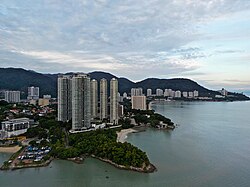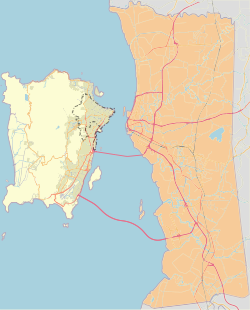Tanjong Bungah[2] (also spelt as Tanjung Bungah) is a suburb of George Town in the Malaysian state of Penang. It is located along the northern coast of Penang Island between Batu Ferringhi and Tanjong Tokong, about 6.5 km (4.0 mi) northwest of the city centre.
Tanjong Bungah | |
|---|---|
Suburb of George Town | |
| Other transcription(s) | |
| • Mandarin | 丹绒武雅 (Simplified) 丹絨武雅 (Traditional) Dān róng wǔ yǎ (Pinyin) |
| • Hokkien | Tan-jiông-bú-ngá (Tâi-lô) |
| • Tamil | தஞ்சோங் பூங்கா |
 | |
 | |
| Coordinates: 5°28′7″N 100°17′8″E / 5.46861°N 100.28556°E | |
| Country | |
| State | |
| City | |
| Government | |
| • Local government | Penang Island City Council |
| • Mayor of Penang Island | Rajendran P. Anthony |
| • Tanjong Bunga State Assemblyman | Zairil Khir Johari (PH-DAP) |
| • Bukit Bendera Member of Parliament | Syerleena Abdul Rashid (PH-DAP) |
| Area | |
• Total | 2.8 km2 (1.1 sq mi) |
| Population (2020)[1] | |
• Total | 14,271 |
| • Density | 5,100/km2 (13,000/sq mi) |
| Demographics | |
| • Ethnic groups | |
| Time zone | UTC+8 (MST) |
| • Summer (DST) | Not observed |
| Postal code | 11200 |
| Website | mbpp |
Tanjong Bungah is locally known as a beach destination, with several hotels and resorts lining the beaches within the area. Decades of urbanisation have also led to the mushrooming of residential high-rises at the suburb and attracted a significant expatriate population; foreigners made up 9.2% of Tanjong Bungah's population as of 2020[update].[1]
Etymology
editTanjong Bungah, which means Flower Cape in Malay, was so named due to the several smaller promontories that jut out to the sea along the cape.
History
editTanjong Bungah was formerly a quiet fishing village populated by Malay and Chinese fishermen. It only gained prominence as a beach destination of choice for locals and tourists in the 1950s. At the time, Batu Ferringhi had yet to be developed. The pristine waters off Tanjong Bungah also attracted two local swimming clubs into the area – the Penang Swimming Club and the Penang Chinese Swimming Club.
The Royal Australian Air Force personnel who were stationed in Penang during the Malayan Emergency and the Indonesian Confrontation would escape to their residences at Tanjong Bungah, known as the Hillside.[3] The spouses of the Australian servicemen also operated an amateur English language radio station – Radio RAAF – which could be tuned in throughout Penang and parts of neighbouring Kedah.
The urbanisation of Tanjong Bungah began in the 1980s, leading to the construction of numerous residential high-rises along the shoreline. The development of Tanjong Bungah has also attracted expatriates who chose to retire on Penang Island, as the suburb is located within commuting distance of the city centre, the shopping malls at Tanjong Tokong and the beaches of Batu Ferringhi.[4] Four international schools have been established here as well – Dalat International School, Prince of Wales Island International Primary School, Pelita International School and Tenby International School.
Tanjong Bungah was one of the hardest hit areas during the 2004 Indian Ocean tsunami that ultimately claimed a total of 52 lives in Penang.[5] The Floating Mosque was subsequently built in 2005 and is now a major landmark at Tanjong Bungah.
Geography
edit0.6miles
Swimming
Club
International School
Hill
Click link at the top right corner to zoom in.
Demographics
editAs of 2020[update], Tanjong Bungah was home to a population of 14,271, resulting in a population density of 5,097/km2 (13,200/sq mi).[1] Ethnic Chinese constituted over 70% of the area's population, while Malays formed another 10%. The suburb's expatriate community made up over 9% of the population, followed by Indians at nearly 8%.
Transportation
editThe main thoroughfare within Tanjong Bungah is the coastal Jalan Tanjong Bungah, part of Federal Route 6.[6] The road continues on from Jalan Tanjong Tokong, cutting through the heart of the Tanjong Bungah until it becomes Jalan Batu Ferringhi near the western edge of the suburb. Alternatively, Vale of Tempe Road, stretching along the hills further inland, is used by motorists to exit Tanjong Bungah towards the neighbouring Tanjong Tokong suburb and on to the city centre, and vice versa.[7]
Rapid Penang buses 101, 102 and 104 serve the residents of the suburb, by connecting Tanjong Bungah with various destinations in the city, such as Tanjong Tokong, Batu Ferringhi, the Penang International Airport and Queensbay Mall.[8][9][10]
In addition, a short cycling lane has been installed within Tanjong Bungah as part of the move to encourage cycling as a form of alternative transportation. The 1.2 km (0.75 miles)-long cycling lane, painted in green and measuring about 90 cm (35 in) in width, stretches between Flamingo Hotel and Dalat International School.[11][12] At the time of its launch in 2013, it was the first dedicated cycling lane in Penang.
Education
editA total of two primary schools, one high school and two international schools are located within Tanjong Bungah.
Primary schools
High schools
- SMK Tanjung Bunga[15]
International schools
- Prince of Wales Island International Primary School[16]
- Dalat International School
Apart from the aforementioned educational institutions, Tanjong Bungah is home to College General, a Catholic seminary founded in 1808, and a Royal Malaysian Air Force training school.[17][18]
Health care
editThe Mount Miriam Cancer Hospital, situated at Jalan Bulan between Tanjong Bungah and Tanjong Tokong, is a private hospital that specialises in cancer treatments.[19]
Sports
editThe Penang Swimming Club at Jalan Tanjong Bungah, overlooking the sea, has a history stretching back to the 1900s.[20][21] Originally a single-storey wooden structure, an Olympic-sized swimming pool was built in 1930. The club also initially restricted membership to Europeans; this discriminatory practice only ended in the 1940s. Today, aside from the swimming pool, the club organises regattas, sailing competitions and other aquatic sports classes for its members.
References
edit- ^ a b c d e "MyCensus 2020: Mukim/Town/Pekan". Department of Statistics Malaysia. Putrajaya: 174–175. February 2024. ISBN 9789672537069.
- ^ "Dokumen Gazetir Pulau Pinang Pulau Mutiara 2022" (PDF) (in Malay). Jawatankuasa Kebangsaan Nama Geografi (JKNG) Malaysia. p. 15.
- ^ "This is Radio R double A F… | Wong Chun Wai". wongchunwai.com. Retrieved 2016-11-11.
- ^ "Where to live in Penang – Penang For Expats". Penang For Expats. 2013-11-04. Retrieved 2016-11-11.
- ^ "Victims of 2004 tsunami back on their feet in no time thanks to Govt's prompt action – Nation | The Star Online". www.thestar.com.my. Retrieved 2016-11-11.
- ^ "Tanjung Bungah – More Popular Than Ever". Tanjung Bungah – More Popular Than Ever, TANJUNG BUNGAH, MORE POPULAR THAN EVER. Retrieved 2017-05-20.
- ^ Sekaran, R. "Road reopens ahead of deadline – Nation | The Star Online". Retrieved 2017-05-20.
- ^ "Baru". Archived from the original on 2017-10-20.
- ^ "Baru". Archived from the original on 2016-12-04.
- ^ "New 104". Archived from the original on 2016-07-02.
- ^ "Bicycle lanes set to open in Penang – Nation | The Star Online". www.thestar.com.my. Retrieved 2017-05-20.
- ^ "For Penang, bike lanes a work in progress". 2013-11-25. Retrieved 2017-05-20.
- ^ "SK TANJUNG BUNGA – PULAU PINANG – Carian Sekolah Malaysia". www.sekolahmy.com (in Malay). Retrieved 2017-05-20.
- ^ "SJK(C) POAY WAH – PULAU PINANG – Carian Sekolah Malaysia". www.sekolahmy.com (in Malay). Retrieved 2017-05-20.
- ^ "SMK TANJONG BUNGA – PULAU PINANG – Carian Sekolah Malaysia". www.smktanjongbunga.com (in Malay). Retrieved 2017-05-20.
- ^ "Private Middle School in Tanjung Bungah Penang | POWIIS". www.powiis.edu.my. Retrieved 2024-11-22.
- ^ Khoo, Salma Nasution (2009). Penang and Its Region: The Story of an Asian Entrepôt. Singapore: National University of Singapore. ISBN 978-9971-69-423-4.
- ^ "School for RMAF officers – Community | The Star Online". www.thestar.com.my. Retrieved 2017-05-21.
- ^ "Malaysia Penang Mount Miriam Cancer Hospital –Cancer treatment with three Linear Accelerators, Mammogram, Ultrasound, X-ray, PET-CT Scan, CT Scan". www.mountmiriam.com. Retrieved 2017-05-21.
- ^ "The Cherished Clubs of Penang". The Cherished Clubs of Penang. Retrieved 2017-05-21.
- ^ "Penang Swimming Club". Time Out Penang. Retrieved 2017-05-21.

